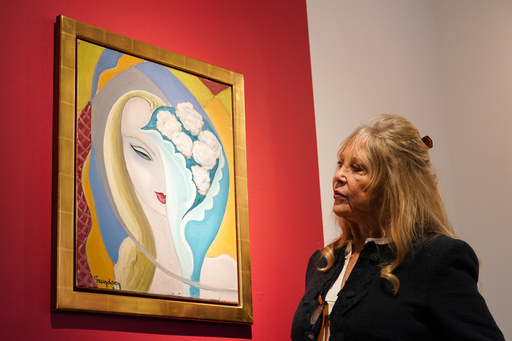LONDON (AP) — Pattie Boyd was at the epicenter of the Swinging 60s, but not always the center of attention.
The model and photographer, who was often in the shadow of her rock icon husbands George Harrison and Eric Clapton, comes into sharp focus through a trove of letters, photos and other items she is selling at Christie’s auction house.
The collection, which went on public display at Christie’s London headquarters on Friday, provides a glimpse into the heart of the 1960s and 70s counterculture. The 111 lots up for sale include affectionate letters from both Harrison and Clapton, alongside clothing, jewelry, drawings and photographs — some of Boyd, and some by her.
If Boyd, 79, feels a pang at parting with them, she isn’t saying.
“I look back without emotion,” she told The Associated Press. “I can feel slightly sentimental, but not emotional.
“I’ve lived with all of these photographs and objets for so long — 40, 50 years,” she said. “I want other people to enjoy them.”
Boyd is famous as a musicians’ muse, inspiration for The Beatles’ song “Something,” composed for her by Harrison, as well as for Clapton’s scorching “Layla” and sweet “Wonderful Tonight.”
The auction includes love letters from Clapton, written while Boyd was married to Harrison, and the original cover artwork for Derek and The Dominos’ 1970 album “Layla and Other Assorted Love Songs,” a painting of a blond model who reminded Clapton of Boyd. The painting is estimated to sell for between 40,000 and 60,000 pounds ($51,000 and $76,000).
Harrison’s handwritten lyrics for the song “Mystical One” are on offer with an estimated price of 30,000 to 50,000 pounds ($38,000 to $63,000).
Boyd is an accomplished photographer, and the sale includes both large-scale portraits and informal Polaroids of Harrison, Clapton and other musicians, including Mick Jagger, Pete Townshend and Ronnie Wood.
“This is very much a snapshot of her life,” said Christie’s head of sale Adrian Hume-Sayer.
Hume-Sayer said the appetite for 1960s music memorabilia is growing, even as undiscovered material becomes scarcer year by year.
“This is quite unusual because it’s primary provenance,” he said. “A lot of the material out there is on the secondary market … but here you’ve got it coming directly from the person who was there. Pattie’s had this all of her life.
“It’s that visceral link with (a) moment that means so much to so many people that makes it so interesting.”
Taken as a whole, the collection feels both personal and revealing.
In one room is a psychedelic acid green and pink minidress worn by Boyd in the 1960s. In another stands an ornate grandfather clock that was a wedding present to Boyd and Harrison from Beatles manager Brian Epstein in 1966.
There are handwritten letters from Harrison — “say hello to Hubby!” — and a handmade Christmas card he gave Boyd in 1968.
Letters and postcards from Clapton – in extremely elegant handwriting — provide shapshots from the rock star life. In one he says he’s off to the Caribbean island of Montserrat “to work on Sting’s album.” Another reveals: “Here I am in South America. Everybody’s got dodgy tummies.”
Harrison and Boyd divorced in 1977, and he died in 2001. In a 2007 memoir, Boyd described Harrison as her soulmate.
Her turbulent 10-year marriage to Clapton, which ended in 1989, was marred — as the musician later acknowledged — by his alcoholism.
Boyd says she feels no bitterness.
“That was almost like another lifetime ago,” she said. “And he has his own life and I have my own life. But this is just a bit of history that we shared.”
Mostly, she recalls the “great fun” of the 1960s, a seismic era whose creative influence rumbles across the decades.
“Sometimes I can be walking down a street somewhere in London, and I see a girl wearing what I would have worn in the 60s,” she said. “I mean, how many years ago was that? And it just makes me smile.”
The Pattie Boyd collection is on display at Christie’s until March 21. Online bidding closes March 22.
This website uses cookies so that we can provide you with the best user experience possible. Cookie information is stored in your browser and performs functions such as recognising you when you return to our website and helping our team to understand which sections of the website you find most interesting and useful.
